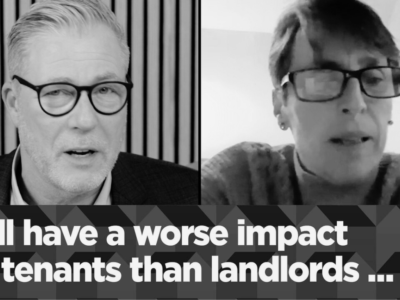Research by estate and lettings agent, Barrows and Forrester, has revealed that rental demand has continued to climb across the vast majority of major UK cities during Q3, as a slow but steady return to the workplace, amongst other things, spurs a greater demand for rental homes within major urban areas.
The Barrows and Forrester Rental Demand Index monitors rental listings across the nation, taking an average demand score for each major city based on where has the highest number of properties already let as a percentage of all rental listings.
The analysis of 23 major UK cities found that rental demand averaged 42.9% during the third quarter of this year, a 9.9% increase on the previous quarter and 6.8% higher than this time last year.
Quarterly movement
Cardiff and Glasgow have enjoyed the largest quarterly uplift with rental demand climbing by 22.1% in both cities.
Bristol (21.9%) and Edinburgh (21.5%) have also seen tenant demand lift by more than 20% in Q3, with Cambridge completing the top five (19.6%).
Other cities to make the top 10 where a quarterly tenant demand uplift are concerned include Manchester (14.8%), Newcastle (11.2%), Southampton (10.9%), Plymouth (10.8%) and Birmingham (10.5%).
Newport is the only city to have seen a decline in demand in Q3, down -5.2% on the previous quarter.
Annual uplift
Cardiff, Cambridge, Edinburgh, Manchester, Bristol, Glasgow and Birmingham also rank within the top 10 where an annual change in tenant demand is concerned.
They are joined by Newcastle (11.7%), Bournemouth (11.1%) and Sheffield (9.2%) who complete the top 10 largest increases in annual rental demand.
Five cities have seen demand in Q3 drop below the levels seen this time last year.
Belfast has seen the largest decline at -40.9%, with Nottingham (-3.5%), Portsmouth (-3.3%), Liverpool (-2.9%) and Plymouth (-0.4%) also seeing a drop.
Managing Director of Barrows and Forrester, James Forrester, commented:
“There have been numerous indicators of late that the UK rental market is starting to once again find its feet after one of the most difficult periods in recent times.
The demand for city rental homes, in particular, was heavily impacted during the pandemic and as a result, many landlords were forced to stomach a significant decrease in rental income in order to secure a tenant.
However, this is starting to change and we’re seeing a notable uplift in demand for rental properties across many of the nation’s major cities.
We expect to see a further boost over the coming months as many tenants look to secure a property ahead of the new year and a fresh start.”
| Table shows rental demand for properties in 23 major UK cities and how this demand has change quarterly and vs the same time last year | |||||
| City | Q3, 2020 | Q2, 2021 | Q3, 2021 | Quarterly Change | Annual Change |
| Cardiff | 33.8% | 47.8% | 69.9% | 22.1% | 36.1% |
| Glasgow | 49.4% | 37.1% | 59.1% | 22.1% | 9.7% |
| Bristol | 63.8% | 57.1% | 79.0% | 21.9% | 15.2% |
| Edinburgh | 16.1% | 15.1% | 36.6% | 21.5% | 20.5% |
| Cambridge | 33.7% | 40.8% | 60.4% | 19.6% | 26.7% |
| Manchester | 29.4% | 31.6% | 46.4% | 14.8% | 17.0% |
| Newcastle | 28.3% | 28.9% | 40.1% | 11.2% | 11.7% |
| Southampton | 41.2% | 36.3% | 47.2% | 10.9% | 6.0% |
| Plymouth | 37.3% | 26.1% | 36.9% | 10.8% | -0.4% |
| Birmingham | 27.9% | 24.5% | 35.1% | 10.5% | 7.2% |
| Nottingham | 49.7% | 36.3% | 46.2% | 9.9% | -3.5% |
| Swansea | 25.4% | 20.6% | 29.8% | 9.2% | 4.4% |
| Portsmouth | 48.6% | 37.1% | 45.4% | 8.3% | -3.3% |
| London | 33.0% | 30.4% | 38.4% | 8.0% | 5.4% |
| Oxford | 36.0% | 35.8% | 42.7% | 6.9% | 6.7% |
| Bournemouth | 61.5% | 66.5% | 72.6% | 6.2% | 11.1% |
| Sheffield | 29.1% | 32.9% | 38.3% | 5.5% | 9.2% |
| Leicester | 22.4% | 20.5% | 24.3% | 3.8% | 1.9% |
| Leeds | 17.5% | 19.8% | 23.4% | 3.5% | 5.9% |
| Liverpool | 30.4% | 25.2% | 27.6% | 2.4% | -2.9% |
| Aberdeen | 6.6% | 11.5% | 13.6% | 2.1% | 7.0% |
| Belfast | 50.9% | 8.3% | 10.0% | 1.7% | -40.9% |
| Newport | 56.7% | 68.5% | 63.3% | -5.2% | 6.6% |
| Average | 36.0% | 33.0% | 42.9% | 9.9% | 6.8% |
| Data sourced from Rightmove | |||||

























Comments